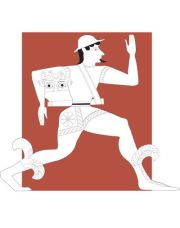Crowdsourcing, Undergraduates, and Digital Humanities Projects
September 3, 2012 § 10 Comments
Crowdsourcing could be a silver bullet for integrating digital humanities methods into the undergraduate curriculum. Why?
Crowdsourcing means getting the general public to do tasks. Jeff Howe explains the phenomenon in “The Rise of Crowdsourcing” (Wired Magazine, June 2006) by analogy with outsourcing. This method of labor is growing for scholarly and cultural heritage projects, and that’s where it intersects with the undergraduate curriculum. Collaborative manuscript transcription projects, like Transcribe Bentham, have received quite a bit of the attention, but there are a variety of opportunities out there for motivated students to engage in the process of digitizing, preserving, and studying collective resources and data. For example, the Perseus Digital Library (whose flagship collections cover the history, literature and culture of the Greco-Roman world) has drafted a call to
Advance our understanding of the Greco-Roman World! Contribute to the Scaife Digital Library — improve existing materials and to create new ones! If you want to understand the present and invent the future then FREE THE PAST!
This call lays out a variety of ways to contribute, including translation, definition, citation, text correction, manuscript transcription, text markup, mapping, and clarifying ambiguous names, words or grammar. If your students answer this call or one like it, what will they gain? Is this just grunt labor or are their potential learning outcomes? Why is this a silver bullet for DH in the classroom?
Crowdsourcing and Liberal Education
Crowdsourcing is a high-impact practice for liberal education. You won’t find it on the list of practices identified by George Kuh, but it enables many of those practices like collaborative learning and undergraduate research. Crowdsourcing involves students in large-scale collaboration and authentic tasks, which contributes to student engagement. They get the sense that they are contributing to something larger, and experience the power of networks to produce knowledge. And, like Kuh’s list of practices, crowdsourcing may help students meet essential learning outcomes of liberal education like gaining knowledge of culture, global engagement, and applied learning.
Essential learning outcomes aim at producing students with transferrable skills; in the globally networked world, being able to produce knowledge in and with the network is a vital skill for students. Students also benefit from exposure to how experts approach a project. While these tasks may seem basic, they lay the groundwork for developing deeper expertise with practice so that participation in crowdsourcing projects may be the beginning of a pipeline that leads students on to more sophisticated digital humanities research projects.
Even if students don’t go on to become digital humanists, crowdsourced projects can help them develop a habit of engagement with the (digital) humanities, something that is just as important for the survival of the humanities. Indeed, a major motivation for humanities crowdsourcing is that involving the public in a project increases public support for that project.
“Give Us Editors!”
 As the Perseus Project reminds us there is work to be done and our undergraduates can do it. Greg Crane issued the call to undergrads in Give Us Editors! Re-inventing the edition and re-thinking the humanities, where he explains that there are at least 13,000 already digitized texts in Latin, and “1.7 billion words in these books are probably unique Latin texts and thus represent a corpus almost one hundred times larger than the classical corpus”. Crane argues that we need editors to help us edit those scanned books and indeed, “the entire record of humanity”. This is humanities data; while interested amateurs from the general public can contribute, undergraduates have the benefit of being trained and supervised. And work like this has a low barrier to entry, so even beginning undergrads can do it. Outside of these editing tasks, Chris Blackwell and Tom Martin argue persuasively in “Technology, Collaboration, and Undergraduate Research” that undergrads can write general knowledge online articles for the general public—again helping increase the value of the humanities outside of the academe.
As the Perseus Project reminds us there is work to be done and our undergraduates can do it. Greg Crane issued the call to undergrads in Give Us Editors! Re-inventing the edition and re-thinking the humanities, where he explains that there are at least 13,000 already digitized texts in Latin, and “1.7 billion words in these books are probably unique Latin texts and thus represent a corpus almost one hundred times larger than the classical corpus”. Crane argues that we need editors to help us edit those scanned books and indeed, “the entire record of humanity”. This is humanities data; while interested amateurs from the general public can contribute, undergraduates have the benefit of being trained and supervised. And work like this has a low barrier to entry, so even beginning undergrads can do it. Outside of these editing tasks, Chris Blackwell and Tom Martin argue persuasively in “Technology, Collaboration, and Undergraduate Research” that undergrads can write general knowledge online articles for the general public—again helping increase the value of the humanities outside of the academe.
For the small liberal arts colleges and the many other institutions without digital humanities centers or the resources to support computationally intensive projects, crowdsourcing also offers a feasible avenue to digital scholarship without unduly taxing institutional resources—financial resources, infrastructure, or technical expertise. It may also be a gateway drug for faculty members interested in trying out digital methods before committing to a large-scale research project.
Why Not?
So, what are the barriers? Well, perhaps typical crowdsourcing tasks, like data entry, are too basic. Perhaps we are exploiting students. Linking the tasks to clear learning outcomes and contextualizing them within the goals or the larger project can help alleviate that concern. Student reflection—either through class discussion or reflective writing—on their contribution can also help them turn this experience into learning.
A larger barrier may be how such a project fits into a class. Does it take up too much time? Is the topic relevant to course content? Can you find a project that fits? At Wheaton College, Prof. Kirk Anderson had students in his Fall 2008 French translation course contribute to a University of Michigan project to translate into English the 1751 Encycopedia edited by Diderot and d’Alembert.
This project fit Anderson’s course because the Wheaton Archives had a copy of the Encylopedia, students were able to choose from 72,000 articles to find ones of the right length to translate, and the project gave them a window into the Enlightenment. By becoming contributors to this large-scale project, students were reliving the original collaborative creation of the Encylopedia.
More and more digital projects are actively soliciting contributions, but they are not always easy to find. In response, we created DHCommons to connect collaborators with projects and vice versa. Projects that register may designate the type of help they want and the level. A search of projects by the collaborator type “undergraduate” brings up a list of 39 projects looking for help. While crowdsourcing projects are often seeking open public contributions, other projects would be happy to have supervised undergraduate contributions. Others, like the History Engine, “an educational tool that gives students the opportunity to learn history by doing the work—researching, writing, and publishing—of a historian,” are specifically designed for undergraduate work.
Despite the external home of crowdsourcing projects, local support and resources may still be a challenge. Students may need access to computers, class time, and mentoring to perform their labor. As Adeline Koh—whose project Digitizing “Chinese Englishmen” is one of those listed on DHCommons as seeking undergraduate collaborators—pointed out to me in a recent conversation, she really needs students who are trained in TEI and faculty members who can supervise their own students. So, contributing to an external project still requires local resources.
In the end, crowdsourcing or other external projects, offer excellent opportunities to engage undergraduates in applied, collaborative digital humanities work, but their instructors must decide whether a given project fits their learning goals to decide whether it is worth committing the resources needed to contribute to these projects.

[…] Crowding Sourcing, Undergraduates, and Digital Humanities Projects – Something that I value about the digital humanities is its spirit of inclusivity. This blog […]
[…] up-to-date account of other “crowdsourced” undergraduate research in a recent blog post from Rebecca Frost Davis, program officer for the humanities at the National Institute for […]
[…] the spirit of my post about undergraduates and crowdsourcing, here is another opportunity to get undergraduates involved in a large digital project, this time […]
[…] just read Rebecca Frost Davis’ excellent post about crowdsourcing & undergraduate education. It (much more eloquently) gets at much I was […]
[…] Earlier steps might include using digital archives as course materials in place of textbooks or contributing to digital archival projects through crowdsourcing. Later steps would include collaborative undergraduate research with faculty on digital […]
[…] Rebecca Frost Davis. “Crowdsourcing, Undergraduates, and Digital Humanities Projects.” Rebecca Frost Davis: Liberal Education in a Networked World, September 3, 2012. https://rebeccafrostdavis.wordpress.com/2012/09/03/crowdsourcing-undergraduates-and-digital-humanitie…. […]
Reblogged this on researcheire and commented:
This is a really interesting article. Consider Crowdcube. Crowdcube helps startup and growing businesses to raise business finance by letting people invest via our equity crowdfunding platform
Reblogged this on Digital A-Rae.
[…] how to has procured its information and what individuals each relies on to compile said information. Crowdsourcing, Undergraduates and Digital Humanities Projects by Rebecca Frost David, the Director of Instructional and Emerging Technology at St. Edward’s […]
[…] just read Rebecca Frost Davis’ excellent post about crowdsourcing & undergraduate education. It (much more eloquently) gets at much I was […]